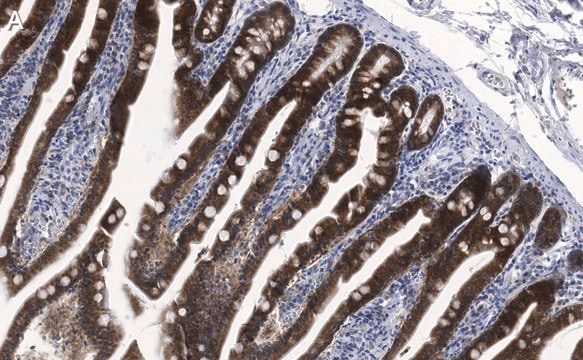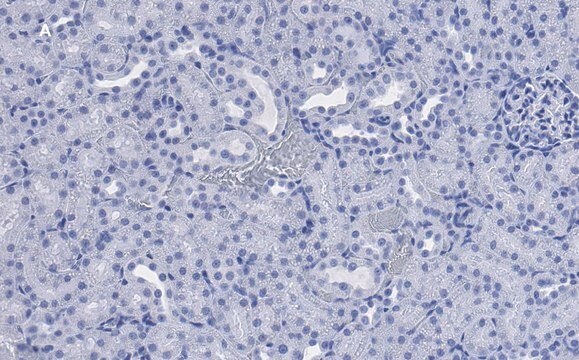General description
We are committed to bringing you greener alternative products, which adhere to one or more of The 12 Principles of Green Chemistry.This antibody is Preservative-free, produced without the harm or sacrifice of animals and exceptionally stable to allow for ambient shipping and storage if needed and thus aligns with "Waste Prevention", "Designing Safer Chemicals" and "Design for Energy Efficiency".
Click here for more information.
ZooMAb antibodies represent an entirely new generation of recombinant monoclonal antibodies.
Each ZooMAb antibody is manufactured using our proprietary recombinant expression system, purified to homogeneity, and precisely dispensed to produce robust and highly reproducible lot-to-lot consistency. Only top-performing clones are released for use by researchers. Each antibody is validated for high specificity and affinity across multiple applications, including its most commonly used application. ZooMAb antibodies are reliably available and ready to ship when you need them.
Learn more about ZooMAb here.Specificity
Clone 1N19 is a ZooMAb rabbit recombinant monoclonal antibody that detects p50 and p105 subunits of NF-kB. It targets an epitope with in 16 amino acids from the internal region.
Immunogen
KLH-conjugated linear peptide corresponding to 16 amino acids from the internal region of human p105 subunit of NF-kB (C-terminal half of p50 subunit).
Application
Anti-NF-kB p50/105, clone 1N19 ZooMAb, Cat. No. ZRB2082, is a recombinant Rabbit Monoclonal Antibody that specifically targets Nuclear factor NF-kappa-B p105 subunit and has been tested for use in Immunocytochemistry, Immunohistochemistry (Paraffin), and Western Blotting.
Western Blotting Analysis: A 1:1,000 dilution from a representative lot detected NF-kB p50/105 in NIH3T3, A431, and Raji cell lysates.
Immunohistochemistry (Paraffin) Analysis: A 1:100 dilution from a representative lot detected NF-kB p50/105 in human tonsil, human prostate cancer and mouse spleen tissue sections.
Immunocytochemistry Analysis: A 1:1,000 dilution from a representative lot detected NF-kB p50/105 in HeLa cells.
Target description
Nuclear factor NF-kappa-B p105 subunit (UniProt: P19838; also known as DNA-binding factor KBF1, EBP-1, Nuclear factor of kappa light polypeptide gene enhancer in B-cells 1) is encoded by the NFKB1 gene (Gene ID: 4790) in human. NF- B family of transcription factors consists of five members in mammalian cells: NF-kB1 (p50/p105), NF-kB2 (p52/p100), RelA (p65), RelB, and c-Rel that associate to form various homodimeric or heterodimeric combinations. All members of NF-kB family share a highly conserved Rel homology domain (RHD), which is responsible for DNA binding, dimerization, and interaction with IkBs. The p50/RelA (p65) heterodimer is the major NF-kB complex in most cells. The p50 subunit of NF-kB (aa 1-433) is synthesized as a precursor molecule of 105 kDa (p105) (aa 1-968) and the subsequent processing of p105 releases the N-terminal p50 subunit that contains the Rel homology domain. The p50 subunit binds to the kappa-B consensus sequence 5′-GGRNNYYCC-3′, located in the enhancer region of genes involved in immune response and acute phase reactions. The carboxy-terminal region of p105 contains seven copies of an ankyrin-related sequence. The activity of NF-kB is tightly regulated by its interaction with inhibitory IkB proteins, which in most resting cells sequesters NF-kB in the cytoplasm in an inactive form. Unlike normal cells, in most cancer cells NF-kB is constitutively active and resides in the nucleus. Several key processes, such as self-sufficiency in growth signals, insensitivity to growth inhibitors, evading apoptosis, unlimited replicative potential, tissue invasion, and sustained angiogenesis, are all enhanced following NF-kB activation. This ZooMAb recombinant monoclonal antibody, generated by our propriety technology, offers significantly enhanced specificity, affinity, reproducibility, and stability over conventional monoclonals. (Ref.: Liou, HC et al., (1992). EMBO J. 11(8); 3003 3009; Yu, Y., et al. (2009). Curr. Cancer Drug Targets 9(4); 566-571).
Physical form
Purified recombinant rabbit monoclonal antibody IgG, lyophilized in PBS with 5% Trehalose, normal appearance a coarse or translucent resin. Contains no biocide or preservatives, such as azide, or any animal by-products. Larger pack sizes provided as multiples of 25 μL.
Reconstitution
Reconstitute lyophilized antibody pellet with 25μL of ultrapure water or Phosphate Buffered Saline (PBS). Please refer to our
reconstitution protocol and the specific application guidance on the suggested starting dilutions and sample type.
Storage and Stability
Recommend storage of lyophilized product at 2-8°C; Before reconstitution, micro-centrifuge vials briefly to spin down material to bottom of the vial; Reconstitute each vial by adding 25 μL of filtered lab grade water or PBS; Reconstituted antibodies can be stored at 2-8°C, or -20°C for long term storage. Avoid repeated freeze-thaws.
Legal Information
ZooMAb is a registered trademark of Merck KGaA, Darmstadt, Germany
Disclaimer
Unless otherwise stated in our catalog or other company documentation accompanying the product(s), our products are intended for research use only and are not to be used for any other purpose, which includes but is not limited to, unauthorized commercial uses, in vitro diagnostic uses, ex vivo or in vivo therapeutic uses or any type of consumption or application to humans or animals.


















